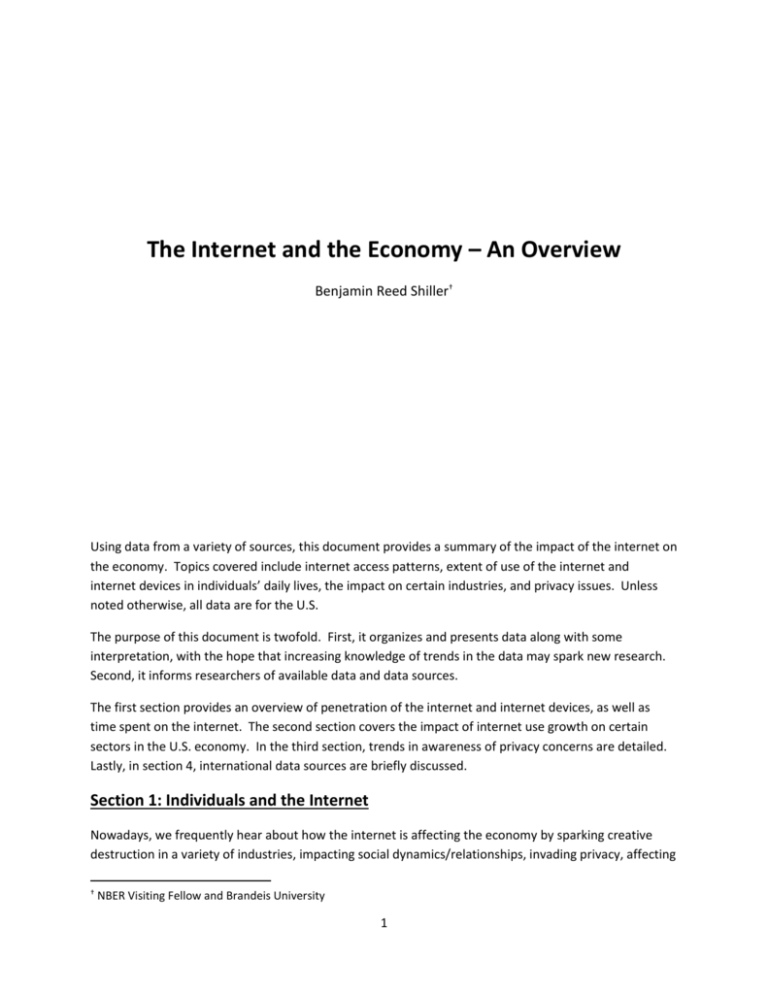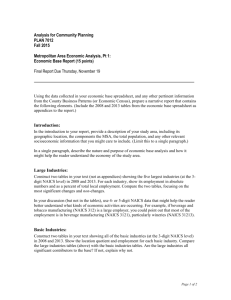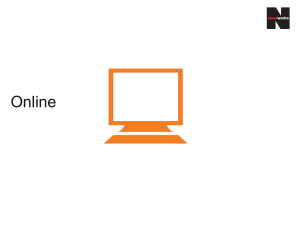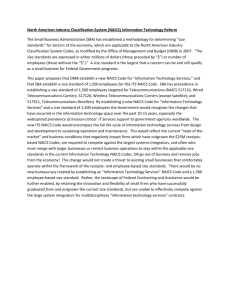Schiller Internet and Economy
advertisement

The Internet and the Economy – An Overview Benjamin Reed Shiller† Using data from a variety of sources, this document provides a summary of the impact of the internet on the economy. Topics covered include internet access patterns, extent of use of the internet and internet devices in individuals’ daily lives, the impact on certain industries, and privacy issues. Unless noted otherwise, all data are for the U.S. The purpose of this document is twofold. First, it organizes and presents data along with some interpretation, with the hope that increasing knowledge of trends in the data may spark new research. Second, it informs researchers of available data and data sources. The first section provides an overview of penetration of the internet and internet devices, as well as time spent on the internet. The second section covers the impact of internet use growth on certain sectors in the U.S. economy. In the third section, trends in awareness of privacy concerns are detailed. Lastly, in section 4, international data sources are briefly discussed. Section 1: Individuals and the Internet Nowadays, we frequently hear about how the internet is affecting the economy by sparking creative destruction in a variety of industries, impacting social dynamics/relationships, invading privacy, affecting † NBER Visiting Fellow and Brandeis University 1 public health for good (e.g. WebMD/Googleflu) or bad (e.g. texting while driving), etc. What underlies the frequent discussion of benefits and concerns is the increasingly widespread adoption of internet devices. Yet, in many cases individuals have vague or imprecise information about the adoption rates of different types of internet connections and internet devices. In this subsection, I address this absence of good information by presenting relevant data sources. The number of internet users and internet device adopters has increased at a rapid pace over the last decade. As Table 1 shows, computer penetration has more than doubled between 1997 and 2010, reaching 77%. Internet penetration, only 19% in 1997, has grown to 71% in 2010. Moreover, nearly all internet connections (68/71*100 = 96%) now appear to be of the faster broadband variety. Table 1 Computer Internet Broadband 1997 37% 19% 0% Computer and Internet Penetration 1998 2000 2001 2003 42% 51% 56% 62% 26% 42% 50% 55% 0% 4% 9% 20% 2007 2009 62% 51% 69% 64% 2010 77% 71% 68% Data are from the CPS supplement surveys. Extracted from U.S. Depatment of Congress (2011a), U.S. Depatment of Congress (2011b), and Greenstein and McDevitt (2010). Links: http://www.ntia.doc.gov/data/CPS2010_Tables_ Description: The special Internet Use Supplement of the Consumer Population Survey’s (US Census/BLS) periodically surveys about 50,000 households and 129,000 individuals in the U.S. about their computer and internet use. Tables depicting trends by various demographics are also available. Microdata may be available. Tables 2 and 3 highlight another trend – consumers have moved more and more towards smaller, portable devices, and increasingly have access to the internet wherever they go. While desktop penetration has actually dropped, laptop penetration has grown dramatically, nearly doubling between 2006 and 2011. MP3 players, e-readers, and tablets show rapid rates of growth. Table 2 2006 Apr Cell phone Desktop Laptop mp3 player Game 73% 68% 30% 20% Electronic Device Penetration 2007 – 2008 2009 – 2010 – Dec Apr Apr May 75% 65% 37% 34% 78% 65% 39% 37% 85% 64% 47% 45% 41% 2 82% 62% 55% 46% 42% 2011 – May 2012 Jan 83% 57% 56% 44% 87% console e-reader Tablet 2% 4% 3% 12% 8% 19% 19% Pew (2012). Links: http://pewinternet.org/Static-Pages/Trend-Data-(Adults).aspx, http://pewinternet.org/StaticPages/Data-Tools/Download-Data.aspx Description: Pew, a nonprofit, nonpartisan “fact tank,” surveys individuals on a variety of topics. Of particular interest is their Internet and American Life Project. A large number of questions about internet use are asked, though some inconsistently, in their surveys. Raw data is available to researchers. Summary statistics are available as well, split up by adults (18+) and teens (12-17). Of particular interest is the growth in penetration rates of smart phones and data plans. As Table 3 shows, smartphone penetration has nearly quadrupled between 2008 and 2011, reaching 42%. Not surprisingly, unlimited data plan penetration shows similar growth. Table 3 Smartphone Penetration Among Mobile Subscribers Unlimited December Smartphone Data of year: Ownership plans* 2008 11% 16% 2009 16.8% 21.3% 2010 27.0% 29.0% 2011 42% Comscore (2010a,2011,2012). * Unlimited data plans can be applied to "feature phones," in addition to smart phones. Generally, smart phones are defined by having "3rd party" operating systems on multiple phones. This includes IOS since it runs on multiple iPhone versions. Feature phones, by contrast, have operating systems specific to the phone, and typically have few available apps. For more, see Lee (2010). Links: http://www.comscore.com/Press_Events/Presentations_Whitepapers/2010/The_2009_U.S._Digital_Yea r_in_Review http://www.comscore.com/Press_Events/Presentations_Whitepapers/2011/2010_US_Digital_Year_in_ Review http://www.comscore.com/Press_Events/Presentations_Whitepapers/2012/2012_Mobile_Future_in_F ocus 3 Descriptions: Comscore uses software voluntarily installed on millions of computers to record consumers’ online activity and purchase behavior. In addition to data for purchase (may be available through Wharton’s WRDS), various statistics can be gleaned from press releases. Given the growth in adoption rates, it is not surprising that the internet now plays a more central role in peoples’ lives. Table 4 shows that time spent on the internet continues to increase. While the definition of sample changed several times in the years included in Table 4, precluding direct comparisons over long time horizons, one can easily see steady year over year growth when considering short time frames where the sample definition remained constant. Table 4 Time Spent on Internet Hours Per Week Sample 20002001 8.65 Households with home internet connections 2003 2004 2005 2006 7.39 7.79 8.33 9.16 Households accessing internet more than 3 times Households accessing internet more than 3 times Households accessing internet more than 3 times Households accessing internet more than 3 times 2007 2008 2009 2010 4.32 4.96 5.50 6.13 All 18+ households All 18+ households All 18+ households All 18+ households Forrester Technographics. Obtained from Goldfarb and Prince (2008) and Brynjolfsson and Oh (2012). *Note the criterion for the sample changed in 2003 and 2007, preventing direct comparisons at these junctures Links: http://www.forrester.com/home Description: Forrester Technographics uses an annual mail survey of approximately 40,000 households, intended to be nationally representative. Data is available for purchase. Section 2: The E-conomy and Old-conomy It is common knowledge that the internet is a driving force of change in the structure of our economy. This section gives specific information regarding its impact, and highlights differences in the impact across industries. The End of a “Series of Tubes” 4 Before one can use all that the internet has to offer and before business can earn revenues from consumers via the internet, consumers must have access to the internet. Provision of internet access itself could be a big sector of the internet economy, given the aforementioned internet adoption rates. Table 5 below shows growth in access revenues in the US from all sources, including individual consumers and businesses. Not surprisingly, growth has been dramatic. While dial-up revenue has declined, revenue from cable and DSL connections shows strong increases. The table shows that total access revenues alone, excluding wireless, were over $50 billion in 2010. Wireless access revenues grew at a more rapid rate than cable and DSL. A rarely used form of access five years ago, revenues from wireless services reached nearly $30 billion by 2010. Table 5 Internet Service Provider Revenues (in Millions of Dollars) in the U.S.* Dial Up Cable DSL Wireless (Excl. Satellite) 1998 $5,499 $138 1999 $8,966 $274 2000 $12,345 $903 2001 $10,339 $2,364 $4,917 2002 $10,596 $3,743 $4,343 2003 $10,665 $6,702 $4,329 2004 $10,585 $8,582 $4,342 2005** $10,281 $11,568 $14,315 2006 $8,399 $13,736 $15,272 $7,650 2007 $6,924 $16,281 $20,045 $12,731 2008 $5,966 $18,070 $22,468 $20,069 2009 $5,431 $19,322 $25,020 $24,602*** 2010 $5,082 $20,944 $28,640 $28,604 U.S. Department of Commerce (2000a, 2004a, 2010a). *Dial-up revenue corresponds to NAICS code 514191 prior to 2005, and NAICS code 518111 thereafter. Cable modem corresponds to NAICS code 5175. DSL corresponds to NAICS code 5133 prior to 2005, and NAICS code 5171 from 2005 onwards. Wireless revenue corresponds to NAICS code 517212. ** The sample used to estimate total revenues changed in 2001 and 2005, potentially explaining large changes in those years. In 2004, the Dept. of Commerce surveyed both the new and old samples, allowing direct comparison. The revenues estimates for the new sample exceeded estimates from the old sample by roughly 33% for dial up, 15% for Cable, and 200% for DSL. The respective revenue estimates for 2004 using the new sample were $14,174 million for dialup, $9,924 million for Cable, and $12,616 million for DSL. See U.S. Department of Commerce (2005a). ***Estimates for a given year change year to year based on cumulative available information. Occasionally, estimates for the same year varied wildly over time. For example, the original 2009 revenue estimate in the 2009 report for wireless access revenue data was $10,101,000. In the 2010 report, the estimate for that same year, 2009, was revised upwards to $24,604. Links: http://www.census.gov/services/index.html Description: The U.S. Department of Commerce’s Service Annual Survey collects data on quite a few revenue variables, expenditures variables, etc., from a sample of companies in a variety of sectors. This data is used to generate total industry estimates. Reporting is mandatory, so the response rate is excellent. Due to the privacy concerns of companies reporting, micro data is not available. 5 Data from the consumer expenditure survey provides a separate estimate on expenditures from consumers alone. Table 6, which contains this information, shows that access revenues from consumers are about $35 billion, comprising over half of all non-wireless revenues. Table 6 Average Annual Expenditures on Internet Access by Consumer Units Total Expenditures Consumer Unit Total Consumer in Millions (Column 1 x Expenditure Units in Thousands Column 2) 1995 $0.39 103,123 $40.22 1996 $13.63 104,212 $1,420.41 1997 $20.65 105,576 $2,180.14 1998 $35.25 107,182 $3,778.17 1999 $48.69 108,465 $5,281.16 2000 $61.36 109,367 $6,710.76 2001 $90.33 110,339 $9,966.92 2002 $107.29 112,108 $12,028.07 2003 $123.92 115,356 $14,294.92 2004 $139.46 116,282 $16,216.69 2005 $153.94 117,356 $18,065.78 2006 $176.44 118,843 $20,968.66 2007 $194.11 120,171 $23,326.39 2008 $219.27 120,770 $26,481.24 2009 $253.49 120,847 $30,633.51 2010 $285.14 121,107 $34,532.45 Department of Labor (1994-2010). Links: http://www.bls.gov/cex/ Description: The U.S. Bureau of Labor’s Consumer Expenditure Survey consists of two surveys – the Quarterly Interview Survey and the Diary Survey. Respondents report their buying habits and expenditures, as well as demographic variables. Micro data is available. Which of several possible reasons explains the increase in access revenues? The adoption data from Table 1 suggests that some combination of increased adoption and adoption of higher quality connections contribute to this revenue increase. But might prices also? Table 7 shows the consumer price index for internet access. Ignoring 2006-2007, when a discrete jump occurred, no strong trend is apparent. Shane Greenstein has speculated that the discrete price jump was due to AOL’s waiving access fees, and providing free service. A back of the envelope calculation 6 would suggest that AOL’s share of the market and price drop would nearly explain this change. However, the CPI has stated that other unnamed reasons are the cause. The discrete jump highlights problems inherent to the CPI index for the internet. First, it does not provide separate price indexes for different connection types (broadband vs. dialup). Second, the CPI does not control for quality changes, such as connection speeds, data limits, and included software. It is well-known that omitted quality changes bias upwards price index estimates. Greenstein and McDevitt (2010) and Wallsten and Riso (2010) attempt to control for quality changes via hedonic price regressions and “augmented matching.” Greenstein and McDevitt’s (2010) price indexes for standalone internet access, which do not include bundles with TV and/or phone, are shown in Table 8. They find a moderate decline in prices over time. Table 7 Internet Consumer Price Index Index 2001 98.1 2002 98.9 2003 99.8 2004 97.4 2005 95.7 2006 92.2 2007 73.2 2008 73.9 2009 76.5 2010 77.0 2011 76.3 U.S Department of Labor (2001b-2011b). Table 8 Residential Standalone Internet Hedonic Price Index Price Index For Cable DSL 2004 1.000 1.000 2005 0.937 1.035 2006 0.863 0.965 2007 0.760 0.908 2008 0.722 0.944 2009 0.864 0.940 Greenstein and McDevitt (2010). Table 9 7 Residential Standalone Broadband Hedonic Price Index Index Type: Paasche Laspeyres Fisher 2007 (1st half) 1.00 1.00 1.00 2007 (2nd half) 0.88 0.94 0.91 2008 (1st half) 0.94 0.97 0.96 2008 (2nd half) 0.83 0.96 0.89 2009 (1st half) 0.88 1.02 0.95 2009 (2nd half) 0.77 1.00 0.89 Wallsten and Riso (2010). Wallsten and Riso (2010) provide a second price index estimate. They leverage a more detailed dataset, compared with Greenstein and McDevitt (2010), that includes data on more types of quality changes, but covers a shorter timeframe. Their results, in Table 9, show even greater price declines. Controlling for quality, it seems prices of internet access have declined noticeably. Somewhat surprisingly, neither set of authors found evidence of price declines for broadband bundles, which include TV and/or phone in addition to internet. For business internet access, Wallsten and Riso (2010) find similar, though less dramatic declines in prices of broadband connections. See Table 10. Table 10 Business Standalone Broadband Hedonic Price Index 2007 2007 2008 2008 2009 (1st half) (2nd half) (1st half) (2nd half) (1st half) Modified Laspeyres Index 1.00 0.94 0.89 0.89 0.9 2009 (2nd half) 0.85 Wallsten and Riso (2010). Description: Greenstein and McDevitt (2010) and Wallsten and Riso (2010) use hedonic price regressions and “augmented” matching to estimate price indexes for internet services, separately by broadband, adjusting for quality changes. Greenstein and McDevitt’s (2010) paper covers a longer timespan. Wallsten and Riso’s (2010) paper includes a very large number of variables, accounting well for quality changes missed in other papers. See their papers for details. Ecommerce Access revenues alone are noteworthy. However, it is often believed that the main economic impact of the internet relates to businesses that connect with consumers through the internet, and the brick and mortar stores that are affected. 8 The first, most obvious fact is that consumers are buying more and more on the internet. Between 2004 and 2011, total e-spending more than doubled, reaching over a quarter of a trillion dollars. Table 11 U.S. Ecommerce Expenditures (in Billions) Total (Including travelrelated purchases) Non-travel 2004 $117 2005 $143 2006 2007 2008 $214 $102 $130 2009 $210 $130 2010 $228 $143 2011 $256 $162 Comscore (2005a,2006a,2007a,2010a,2011). “-“ Data not available. Links: http://ir.comscore.com/releasedetail.cfm?ReleaseID=244657 http://ir.comscore.com/releasedetail.cfm?ReleaseID=244666 http://www.comscore.com/fre/Press_Events/Press_Releases/2007/01/E-Commerce_Figures_2006 http://www.comscore.com/Press_Events/Presentations_Whitepapers/2010/The_2009_U.S._Digital_Yea r_in_Review http://www.comscore.com/Press_Events/Presentations_Whitepapers/2011/2010_US_Digital_Year_in_ Review Description: See description above. Websites and Media As more and more individuals spend more and more time online, the number and likely the quality of websites has increased. Figure 1 shows the increase in internet hosts, a proxy for number of websites worldwide, over the last 30 years. The number of hosts doubles every 3-6 years over this period, demonstrating very rapid growth. Figure 1 9 Dec-09 May-11 Jul-08 Feb-07 Sep-05 Apr-04 Nov-02 Jun-01 Jan-00 Aug-98 Oct-95 Mar-97 May-94 Dec-92 Jul-91 Feb-90 Apr-87 Sep-88 Nov-85 Jun-84 Jan-83 10.00 9.00 8.00 7.00 6.00 5.00 4.00 3.00 2.00 1.00 0.00 Aug-81 Log Internet Hosts Internet Hosts (Logged) Internet Systems Consortium. Link: http://www.isc.org/solutions/survey Description: The Internet Systems Consortium Domain Survey reports discovered website hosts (proxy for websites). The free data reports total worldwide hosts. Disaggregated data is available for purchase. The most popular websites see a greater and greater share of internet users, rather than seeing those individuals’ attention being displaced by more specialized websites in the long tail. Table 12 shows the fraction of total internet users accessing selected top internet sites from the top 50 most accessed websites. Note that several websites (Google, Microsoft, Yahoo, and Facebook) have over ¾ of internet users visiting their sites each month, as of December 2011. Facebook in particular is of interest, reaching such high penetration only 7 years after creation. Rome wasn’t built in a day, but it seems a digital Rome might be. Also of note is the growth in popularity of top new sites. The New York Times, for example, is accessed by over 1/3 or internet users in December, 2011. It is not surprising, nor news, that “old-fashioned” print newspapers have not fared well following strong competition from the internet. Both the total number and total circulation have fallen dramatically. See Figure 2. 10 Table 12 Unique Monthly Visitors to Selected Top Sites in December of Each Year, as % of Total Users Website* 2004 2005 2006 2007 2008 2010 2011 Facebook < 7.7% < 8.0% 11.0% 18.9% 28.6% 72.6% 73.5% Google sites 44.5% 50.8% 64.8% 72.4% 78.2% 84.6% 84.9% Microsoft sites 70.4% 68.5% 66.9% 65.4% 65.7% 83.5% 80.4% Yahoo sites 74.1% 73.2% 75.5% 74.4% 76.4% 85.5% 80.1% Amazon 29.9% 33.8% 32.6% 35.5% 37.5% 43.0% 52.0% Wikimedia Foundation Sites < 7.7% 10.2% 22.1% 28.2% 30.6% 36.7% 37.7% Viacom Digital 20.8% 21.6% 23.0% 23.5% 24.3% 39.9% 35.7% CBS digital < 7.7% < 8.0% 13.3% 13.7% 27.7% 40.6% 34.7% Time Warner 71.3% 68.3% 69.4% 65.1% 17.3% < 12.4% < 11.9% Ebay 41.3% 38.1% 48.4% 37.0% 40.9% 33.2% 33.8% NYTimes < 7.7% 20.2% 23.0% 24.2% 24.3% 32.9% 34.7% Walmart 21.1% 22.4% 25.3% 24.1% 25.9% 24.2% 25.3% Weather Channel 17.5% 17.9% 15.5% 22.1% 21.8% 20.9% 24.7% Craigslist < 7.7% < 8.0% 8.8% 13.3% 19.4% 24.1% 19.7% ESPN 9.2% 9.3% 9.3% 11.3% 10.7% 19.0% 19.7% Netflix < 7.7% < 8.0% < 8.4% < 9.3% < 15.8% < 12.4% 15.8% LinkedIn Myspace/Intermix Media < 7.7% < 8.0% < 8.4% < 9.3% < 15.8% 12.5% 15.2% 11.1% 18.9% < 8.4% < 9.3% < 15.8% < 12.4% < 11.9% 2009** Comscore (2005b, 2006b, 2007b, 2007c, 2008, 2010b). Observations for websites not in top 50 are censored. In the above table, such observations are replaced with a “<” sign before the percent unique visitors visiting the 50th most visited website. *Websites may include subwebsites. Changes to classifications of subwebsites are not available. ** 2009 data not available Links: http://ir.comscore.com/releasedetail.cfm?ReleaseID=244666 http://www.comscore.com/Press_Events/Press_Releases/2006/01/2005_E-Commerce_Figures http://www.comscore.com/esl/Press_Events/Press_Releases/2008/01/Top_50_US_Web_Sites http://www.comscore.com/Press_Events/Press_Releases/2007/02/Top_US_Online_Properties http://www.comscore.com/esl/Press_Events/Press_Releases/2008/01/Top_50_US_Web_Sites http://www.comscore.com/Press_Events/Press_Releases/2011/1/comScore_Media_Metrix_Ranks_Top _50_U.S._Web_Properties_for_December_2010 Description: See above description for Comscore 11 Figure 2 Newpaper Trends 7.00 6.00 5.00 4.00 3.00 2.00 1.00 0.00 # Newspapers (in 1,000s) 1940 1949 1954 1959 1964 1969 1974 1979 1984 1989 1994 1999 2004 2009 Total Daily Circulation (in Tens of Millions) Newpaper Association of America - Editor and Publisher International Yearbook Link: http://www.naa.org/Trends-and-Numbers/Circulation/Newspaper-Circulation-Volume.aspx Description: The Newspaper Circulation Volume Data in from Editor and Publisher Yearbook’s provides newspaper count, circulation, and expenditures for members of the Newspaper Association of America (believed to be most newspapers operating in the U.S.). While newspapers have been particularly hard hit, and their problems frequently covered in the news, the internet has had an impact on most forms of media. Figure 3 below, reproduced from Waterman and Ji (2011), nicely presents the trends in revenues from various media sources. Figure 3 Revenues for Various Media Sources as Percent of GDP 12 One of the main impacts of the internet has been to steal advertising revenues. However, the above figure does not distinguish between advertising revenues and other sources of revenues. Data on advertising is available for some industries via the U.S. Service Annual Survey. It is summarized in Table 13. It isn’t surprising to anyone who has read the news the last few years that internet advertising revenues have grown dramatically. However, it may be surprising that advertising revenues in some industries were affected strongly by this, while others were not. For example, while newspapers have seen strong revenue declines, broadcast television has seemingly been unaffected. Radio falls somewhere in between. Table 13 Advertising Revenues (in Billions of Dollars) 2001 2002 2003 2004 2005 2006 2007 Internet Advertising Bureau Online Advertising Census** Web Search Portals 2008 2009 2010 7.2 6.0 7.3 9.6 12.5 16.9 21.2 23.4 22.7 26.0 - - - 4.9* 5.5 8.0 11.4 13.7 - 15.9 13 Companies Publishing Exclusively Online Television Broadcasting Local National Cable and Other Subscription Services Radio Stations Local National Newspapers Print Online Other Classifieds All Other Periodical Publishers All Print General Interest Display (e.g. Billboards) Direct Mail - - - 1.5* 1.8 2.6 3.5 4.3 5.0 5.6 - - - 9.7* 16.3* 10.7 18.0 11.4 18.3 11.2 17.5 10.9 17.8 8.6 15.3 9.7 17.3 12.8 13.4 15.0 16.5 16.1 17.1 18.6 20.0 19.9 21.1 - - - 12.3* 3.8* 9.8 2.9 9.8 3.1 9.8 3.2 8.9 3.1 7.3 2.5 7.4 2.8 32.0 0.3 0.1 - 31.9 0.5 0.1 - 32.4 0.6 0.1 - 33.5 0.7 0.0 12.8* 23.1* 11.2 24.0 10.9 24.0 10.0 23.3 8.1 22.1 6.0 17.3 5.7 16.0 18.4 4.5 10.7 17.8 4.6 10.5 17.8 4.9 10.6 18.8 14.4* 5.4 11.6 14.1 5.7 12.4 15.1 6.2 12.5 15.1 7.1 12.4 14.0 7.2 11.5 10.9 6.2 10.0 9.7 6.4 10.7 U.S. Department of Commerce (2010a). IAB (1999-2010). "-" Data not available, not directly comparable with other years due to changes in NAICS code criteria or changes in the survey, or didn't meet publication standard for sampling variability. * Available in 2005 SAS report. ** Substantial reclassification of companies in the web search and online publishing industries occurred between the NAICS 1997 codes (used until 2004), and the NAICS 2002 codes (used thereafter). The sample of firms used in estimation all changed in 2004, compounding errors in the difference between 2004 and 2005 numbers. Therefore Census statistics before 2005 should not be compared with statistics from 2005 or later. The NAICS codes used to classify revenues by industry type are as follows. Web Search Portals - 519130 (2007 NAICS reclassification), 518112 (2002 NAICS reclassification). Online Publishers - 519130 (2007 NAICS reclassification) 516110 (2002 NAICS reclassification). Television Broadcasting - 51512 (2007, 2002 NAICS reclassifications), 51312 (1997 NAICS reclassification). Cable and Other Subscription Services - 5152 (2007, 2002 NAICS reclassifications), 5132 (1997 NAICS reclassification). Radio Stations - 515112 (2007, 2002 NAICS reclassifications), 513112 (1997 NAICS reclassification). Newspapers – 51111. Periodical Publishers – 51112. Display Advertising – 54185. Direct Mail – 54186. IAB Link: http://www.iab.net/insights_research/industry_data_and_landscape/adrevenuereport Description IAB: The IAB, an advertising business organization, comprised of many members responsible for selling 86% of online advertising in the U.S., reports their estimates of total internet advertising revenues in the U.S. yearly. Service Annual Survey – See links and description above. Employment 14 Often, when new industries disrupt old ones, disrupting firms show strong employment growth. However, in the county business patterns data, industries likely to experience employment growth do not show a strong consistent pattern of growth. This is shown in Table 14. Table 14 Employment Statistics for Selected Industries 2003 2004 2005 2006 2007 Software Publishing Number Employed (in 1000s) Gross Annual Payroll (in Billions of Dollars) Internet Publishing and Broadcasting Number Employed (in 1000s) Gross Annual Payroll (in Billions of Dollars) Data Processing, Hosting, and Related Services Number Employed (in 1000s) Gross Annual Payroll (in Billions of Dollars) Wired Telecommunications Carriers Number Employed (in 1000s) Gross Annual Payroll (in Billions of Dollars) Wireless Telecommunications Carriers (except Satellite) Number Employed (in 1000s) Gross Annual Payroll (in Billions of Dollars) 2008 2009 2010 344.24 328.62 327.64 339.83 346.68 386.41 370.02 ** - - 39.22 39.65 42.97 41.60 40.61 43.27 35.61 37.05 36.15 41.59 46.63 88.66* 91.13 ** - - 2.84 3.51 4.19 5.10 5.14 6.05 403.00 365.92 379.41 385.11 375.47 391.96 387.17 ** - - 20.86 22.68 24.05 27.16 27.28 27.91 855.20 781.41 693.72 634.54 621.71 844.01 840.52 ** - - 69.68 73.83 70.18 73.11 70.58 69.13 266.28 262.06 249.97 241.41 277.62 286.32 277.59 ** - - 15.26 15.89 16.01 17.95 16.42 15.48 U.S. Department of Commerce (1998b-2010b) "-" Data Not Available, or not directly comparable with other years due to a change in NAICS code criteria or changes in the survey. * Definition changed in 2009 to include employment in Web Search Portals. The NAICS code before then was 516110. ** Data unavailable at time of collection. NAICS codes used to classify industries are as follows. Software Publishing – 5112. Internet Publishing and Broadcasting – 516110. Data Processing, Hosting, and Related Services – 518210. Wireless Telecommunications Carriers – 517110. Wireless Telecommunications Carriers (except Satellite) – 517210. Link: http://www.census.gov/econ/susb/ Description: The Statistics of U.S. Businesses provides information on number firms and employment by firm size, geographic region, and industry. Section 3: Privacy 15 A frequently researched topic is privacy on the internet, or lack thereof. Figure 4 shows the increase in research in this area in the field of economics. Figure 4 Percent of Papers with the Word "Privacy" in the Text Among Papers from Econlit 1.2E-03 1.0E-03 8.0E-04 6.0E-04 4.0E-04 2.0E-04 0.0E+00 Year Despite being a concern among researchers, it does not appear to be a growing concern among the population generally. Figure 5 shows the trends in words related to privacy among search terms on Google. Figure 5 16 16 14 12 10 8 6 4 2 0 privacy facebook privacy Week May 23 2004 Oct 17 2004 Mar 13 2005 Aug 7 2005 Jan 1 2006 May 28 2006 Oct 22 2006 Mar 18 2007 Aug 12 2007 Jan 6 2008 Jun 1 2008 Oct 26 2008 Mar 22 2009 Aug 16 2009 Jan 10 2010 Jun 6 2010 Oct 31 2010 Mar 27 2011 Aug 21 2011 Jan 15 2012 Frequency (Not Relative Across Words) Trend in Keyword Search Frequencies opt in internet privacy Date Google Trends. Google Trends: Link: http://www.google.com/trends/ Description: Google Trends reports the trends in frequency of search terms on Google. The site allows one to quickly compare frequency across words over time. However, the relative frequency data appear to be rounded when comparing multiple words. This rounding precludes direct comparison between words occurring at very different frequencies. Note that there is no apparent increasing trend in the keyword “privacy.” “Facebook privacy,” as a keyword, has increased over this time. However, that could be due to the increase in prevalence of Facebook, not privacy. What is interesting are the spikes in the frequency of this search term, which perhaps suggest that consumers become much more sensitive to how their private data are used on social networks at times when newspaper stories highlight privacy concerns. Google Ngrams, which shows the frequency with which words appear in books, yields an intermediate result. Figure 6 shows that privacy as a term may have grown in frequency slightly in books. Figure 6 17 Trends in Frequency of Words in Books 2007 2004 2001 1998 1995 1992 1989 1986 1983 1980 1977 1974 1971 1968 1965 1962 -4.6 Year -4.5 Log Relative Frequency -4.7 -4.8 -4.9 -5 -5.1 -5.2 -5.3 -5.4 -5.5 Year Google Ngrams A likely explanation is that consumers do not concern themselves with privacy on a daily basis. But authors, researchers, and regulators, for whom privacy issues are recognized as an on-going concern, consistently are attentive to privacy issues. If policy makers successfully prevent problems related to privacy, maybe it will never be on consumers’ radar. Link: http://books.google.com/ngrams/ Google Ngrams: Google Ngrams reports the frequency at which words and phrases are used in books by publication year dating far back in time, elucidating trends. The website allows quick comparisons over time across a few words. The underlying data is downloadable, though the files are quite large. Section 4: International Data 18 The focus of this document has been on the U.S. Those interested in international data should refer to data from the OECD Broadband Portal, and the Europe’s Digital Competiveness Report (2010). Wallsten (2008) provides a good discussion of the limitations of international data. References Brynjolfsson, E., and Oh, J.H., “The Attention Economy: Measuring the Value of Free Goods on the Internet”, working paper, 2012. Comscore. “Online Holiday Spending Surges Beyond Expectations, Driving E-Commerce to Record Annual Sales of $117 Billion.” 2005a. Comscore. “Holiday Festivity Drove Web Activity in December, According to comScore Media Metrix Top 50 Online Property Ranking.” 2005b. Comscore. “Online Holiday Spending Boosts E-Commerce to Record Annual Sales of $143 Billion.” 2006a. Comscore. “Holiday-Related Content Drove December Web Activity, According to comScore Media Metrix Top 50 Online Property Ranking.” 2006b. Comscore. “comScore Networks Reports Total Non-Travel E-Commerce Spending Reaches $102 Billion in 2006; up 24 Percent Versus 2005.” 2007a. Comscore. “comScore Media Metrix Releases Top 50 U.S. Web Rankings for December.” 2007b, 2008, 2010b. Comscore. “New Year’s Resolutions Reflected in January U.S. Web Traffic.” 2007c. Comscore. “The 2009 U.S. Digital Year in Review.” 2010a. Comscore. “The 2010 U.S. Digital Year in Review.” 2011. Comscore. “2012 Mobile future in Focus.” 2012. European Commission, “Europe’s Digital Competitiveness Report.” May 2010. Goldfarb, A., and Prince, J. “ Internet Adoption and Usage Patterns are Different: Implications for the Digital Divide, Information Economics and Policy, 20(1), p2-15, 2008. 19 Greenstein, S. and McDevitt, R. “The Broadband Bonus: Estimating Broadband Internet’s Economic Value.” working paper, 2010. IAB Internet Advertising Revenue Report - Full Year Results, 1999-2010. Internet Systems Consortium Host Data, Inc. (http://www.isc.org/). Lee, N., "The 411 - Feature Phones Vs. Smartphones," CNET News, March 1, 2010. Pew. Internet and American Life Project. “Trend Data (Adults).” http://pewinternet.org/DataTools.aspx. Accessed May, 2012. U.S. Department of Commerce, Economics and Statistics Administration, U.S. Census Bureau, Service Annual Survey, 1998a-2010a. U.S. Department of Commerce, U.S. Census Bureau, Statistics of U.S. Businesses. 1998b-2010b. U.S. Department of Commerce, National Telecommunication and Information Administration. “Digital Nation – Expanding Internet Usage.” Washington, 2011a. U.S. Department of Commerce. National Telecommunication and Information Administration. Economics and Statistics Administration. “Exploring the Digital Nation.” Washington, 2011a. U.S. Department of Labor, Bureau of Labor Statistics, Consumer Expenditure Survey, Interview Survey, 1994-2010. U.S Department of Labor, Bureau of Labor Statistics, Consumer Price Index, 2001b-2011b. Wallsten, S., “Understanding International Broadband Comparisons.” Technology Policy Institute Working Paper, 2008. Wallsten, S. and Riso, J., “Residential and Business Broadband Prices, Part 1: An Empirical Analysis of Metering and Other Price Determinants.” Technology Policy Institute Working Paper, 2010. Waterman, D., and Ji, S. “Online vs. Offline in the U.S.: Are the Media Shrinking?.” working paper, 2011. 20






